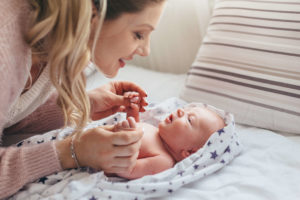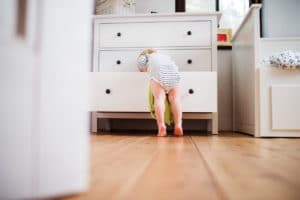Once your baby is born, you’ll soon be asking yourself “When do babies start crawling?” Crawling is an important milestone on the way to independent locomotion. Early on, the baby prepares for this. But when exactly do babies crawl? There is still quite a long way to go, even though motor development occurs from the first days of life. You can expect your baby to start crawling between the sixth and tenth months of life. This is an important process for training motor skills and preparing for walking.
Everything you need to know about this can be found here! When do babies start crawling? This process depends on development and should begin between the sixth and tenth month of life.
Table of contents
When Do Babies Start Crawling – A Rather Long Period Of Time
Once your baby is born and you ask yourself the question “When do babies start crawling?”, you will have to be patient for a few more months. You should also not make comparisons with other babies. For example, if your daughter is already eight months old and is not crawling yet, while your friend’s son is already crawling perfectly at six months, this is no reason to worry. Give your baby the time he needs for his motor development. If your baby can sit, this is already a good prerequisite. As a rule, babies learn to crawl in the sixth to tenth month of life.
When do babies start crawling? This depends on development and various factors. You should observe your baby closely and see what progress it makes in the development of motor skills. You should only inform your pediatrician if your baby moves little overall and is still unable to crawl after its first birthday.
Crawling Has To Be Learned – The Prerequisites For It
Are you wondering when babies start crawling? They can do so when the most important prerequisites are met. The neck muscles must be strong enough for your baby to be able to look forward. Your baby’s arms must also be strong enough so that he can push himself up with his arms. If your baby can do this, he will be able to turn from his back to his stomach and back again.
This strengthens the trunk and back muscles. Some babies already make their first attempts to move around. They crawl, creep and push themselves back and forth on the floor. If your baby can sit, it won’t be long before he or she is moving around the house on all fours. The legs must be strong enough to hold the bottom. When do babies crawl? This works when hands and feet are also well developed and when good coordination is ensured.
Don’t Be Afraid Of Setbacks
When your baby starts his first crawling attempts, you should not be discouraged by setbacks. In the beginning, the legs are usually faster than the hands. The baby lands on its nose. The first crawls will not be without injuries. Your baby’s coordination gets better and better through the crawling process. Your baby becomes more and more dexterous and also reacts to obstacles.
Learning Steps In Crawling
Even though the question “When do babies start crawling?” cannot be answered in such a general way, the same learning steps can be observed in most babies:
- From the prone position, the baby pushes itself up with its arms.
- Your baby can sit without help.
- From sitting, your baby gets on the floor on knees and hands and starts balancing.
- The baby rocks back and forth by leaning on hands and knees.
- Baby crawls by moving knees and arms forward.
How You Can Encourage Crawling Attempts
When do babies start crawling? On the one hand, this depends on how quickly your baby develops, on the other hand, you can encourage it. You don’t have to teach your baby to crawl, but you can support his curiosity. You should create enough space for your baby and put a crawling blanket on the floor. This is safer than having your baby crawl on a smooth floor such as laminate, parquet or tiles. It is important that you make your baby feel safe and secure and encourage him to explore the environment. On the crawling blanket, you can place your baby’s toys so that he or she can see them, but cannot grasp them. He will then be forced to move there if he wants the toys. If it does not succeed, it may cry. You should comfort him and encourage him to try again.
You can also roll a ball in front of your baby. If he wants the ball, he must move away. If your baby is already on his knees and hands on the floor, but he is not crawling yet, you can hold his pelvis and rock him back and forth. He will then get a secure feeling and can try to move around on his own.
Childproofing The Home
If your baby can sit, it’s time to make the apartment safe. There are a few things you should keep in mind:
- If there are stairs, secure them with a gate to prevent your baby from falling down the stairs.
- Use childproof locks for electrical outlets.
- Secure drawers and sharp furniture edges so your baby can’t hurt himself.
- Think about the safety of hot hazards like radiators and fireplaces.
- Move hazards such as furniture that can tip over, cleaning supplies and other chemicals out of your baby’s reach.
To prevent your baby from slipping, you should put on non-slip socks. Your baby’s knees can quickly become red and sore if he falls to his knees during his first attempts to stand up. Equip your baby’s pants with knee pads. Your baby needs a lot of attention now as he explores his surroundings. You should only leave him unattended where there are no sources of danger.
Crawling As An Effort
If you have found the answer to the question “When do babies start crawling?” because your baby is crawling, you should not forget that crawling is strenuous for the baby. If your baby can sit, it is not yet a big effort. However, if he makes his first crawling attempts, it will be noticeable when he sleeps. Dr. Dina Cohen from the University of Haifa found that babies who crawl wake up more often at night. This is not a cause for alarm, however, as it changes quickly. During the waking phases, the babies also stayed awake longer. A change in sleep was observed especially in those who started crawling very early, from the age of five or six months. Dr. Cohen explains these changes with a phase of instability. For the baby, this means psychological reorganization and increased arousal. As locomotion distances the baby from the mother as caregiver, it creates a greater distance that can cause anxiety. This phase of frequent waking extends for about three months.
When Do Babies With Down Syndrome Start Crawling?
Babies with Down syndrome have delayed motor development, which is due to the supernumerary chromosome. When do babies with Down syndrome crawl? The answer to this question depends on the stage of development, just as it does for healthy babies. Shortly after birth, it is not yet possible to determine how severely the baby is affected by Down syndrome. Some babies do not even see shortly after birth that they suffer from Down syndrome. It often takes a long time before the baby can sit. While some babies with Down syndrome learn to crawl like normally developed children, others do not learn until they are 15 months old.
When Do Babies Start Crawling – Factors That Affect This
The question of when babies start crawling depends on several factors:
- Impairments such as Down syndrome.
- Later onset of motor development because your baby is a premature infant.
- Month of birth, as children born in winter usually start crawling earlier than children born in summer.
- Baby’s weight – according to a study by the University of North Carolina at Chapel Hill, children who weigh a lot start crawling later than lighter. babies.
- Motor development is twice as likely to be delayed in heavy babies as in lighter babies.
- Gender with small effects. Girls can sit an average of one month earlier than boys.
When You Should Consult The Pediatrician
If your baby is not crawling by the age of 10 months, this is no cause for concern. However, you should consult the pediatrician if your baby is not yet able to sit. You should also inform the pediatrician if your baby does not show any interest in mobility by his or her first birthday. This includes crawling as well as sliding, crawling or rolling. If your baby cannot use his arms and legs at the same time or in coordinated movements at this age, this is a reason to visit the pediatrician. The situation is different if your baby is a premature baby.
In premature babies, motor development often starts later. The question of when babies start crawling cannot be answered for premature babies in the same way as for other babies. If your baby skips the crawling phase and starts walking right away, you should also inform the pediatrician. About 13 percent of children skip the crawling phase. You should also go to the doctor if your baby only crawls and drags one leg behind. The doctor can determine whether there is a disorder in the musculoskeletal system or in coordination. The physiotherapist can help with various exercises to advance motor development.
What Happens If The Crawling Phase Is Skipped?
If your baby can sit and skips the crawling phase, this does not have to be a cause for concern yet. It is a myth that babies who do not crawl will suffer from dyslexia or other school problems when they reach school age. Physical therapy can be used to promote appropriate development.
What Comes After The Crawling Phase?
If your baby is able to crawl, he or she will then begin what is known as cross crawling. The arm of one side is moved forward or backward in parallel with the leg of the other side. Both halves of the brain and body work perfectly together. This is called bilateral integration. Soon your baby will learn to pull himself up on an object like a table leg and then start walking. Once he has found balance on his feet, he will stand hands-free and then walk with your help.
When Do Babies Start Crawling – Conclusion
When do babies start crawling? This depends on various factors. By the time your baby starts crawling, the neck muscles, arms, legs and back muscles must be well developed. First, your baby learns to sit. Later, he moves to the floor and rocks forward and backward on his hands and knees. With normal development, they begin crawling between six and ten months of age. Some children skip the crawling phase.













9 thoughts on “When Do Babies Start Crawling: The Path To Independent Locomotion”